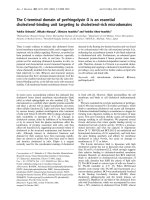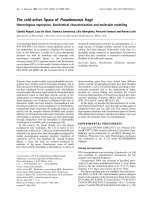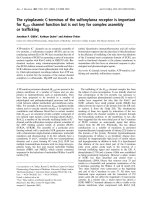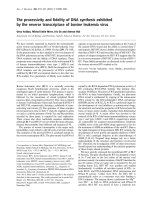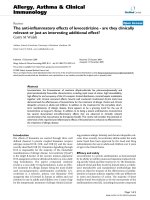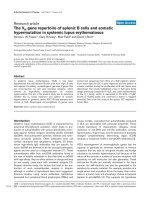Báo cáo Y học: The mitochondrial-lysosomal axis theory of aging Accumulation of damaged mitochondria as a result of imperfect autophagocytosis ppt
Bạn đang xem bản rút gọn của tài liệu. Xem và tải ngay bản đầy đủ của tài liệu tại đây (191.31 KB, 7 trang )
MINIREVIEW
The mitochondrial-lysosomal axis theory of aging
Accumulation of damaged mitochondria as a result of imperfect autophagocytosis
Ulf T. Brunk and Alexei Terman
Division of Pathology II, Faculty of Health Sciences, Linko
¨
ping University, Sweden
Cellular manifestations of aging are most pronounced in
postmitotic cells, such as neurons and cardiac myocytes.
Alterations of these cells, which are responsible for essential
functions of brain and heart, are particularly important
contributors to the overall aging process. Mitochondria and
lysosomes of postmitotic cells suffer the most remarkable
age-related alterations of all cellular organelles. Many
mitochondria undergo enlargement and structural disor-
ganization, while lysosomes, which are normally responsible
for mitochondrial turnover, gradually accumulate an unde-
gradable, polymeric, autofluorescent material called lipofu-
scin, or age pigment. We believe that these changes occur not
only due to continuous oxidative stress (causing oxidation of
mitochondrial constituents and autophagocytosed mater-
ial), but also because of the inherent inability of cells to
completely remove oxidatively damaged structures (biolo-
gical ÔgarbageÕ). A possible factor limiting the effectiveness of
mitochondial turnover is the enlargement of mitochondria
which may reflect their impaired fission. Non-autophago-
cytosed mitochondria undergo further oxidative damage,
resulting in decreasing energy production and increasing
generation of reactive oxygen species. Damaged, enlarged
and functionally disabled mitochondria gradually displace
normal ones, which cannot replicate indefinitely because of
limited cell volume. Although lipofuscin-loaded lysosomes
continue to receive newly synthesized lysosomal enzymes,
the pigment is undegradable. Therefore, advanced lipofuscin
accumulation may greatly diminish lysosomal degradative
capacity by preventing lysosomal enzymes from targeting to
functional autophagosomes, further limiting mitochondrial
recycling. This interrelated mitochondrial and lysosomal
damage irreversibly leads to functional decay and death of
postmitotic cells.
Keywords: aging; autophagocytosis; lysosomes; lipofuscin;
mitochondria; oxidative stress.
INTRODUCTION
Different types of cells within multicellular organisms are
known to age at different rates. Age-related changes are
most prominent in postmitotic cells, such as neurons and
cardiac myocytes, whereas in bone marrow, intestinal
epithelium and other proliferating cell populations, only
minor or undetectable changes occur with age [1,2]. Aging
affects not only cells, but also the extracellular matrix [3],
possibly causing disorders of diffusion and intercellular
communication. However, being responsible for age-related
disturbances of vitally important brain and heart functions,
senescent changes in postmitotic cells play an essential role
in the overall aging process.
Although aging affects many cellular components, per-
haps the most remarkable changes occur in mitochondria
and lysosomes of postmitotic cells. Mitochondria undergo
gradual structural alterations associated with decreased
capacity to produce energy [4–6], while lysosomes progres-
sively accumulate lipofuscin (age pigment), a brown-yellow,
autofluorescent, undegradable, polymeric material [7,8].
Accumulating evidence suggests that age-related damage
is an ineluctable consequence of normal oxygen metabo-
lism, which is associated with a relentless formation of
reactive oxygen species (ROS) [9–11]. Superoxide dismutase,
catalase, glutathione peroxidase, vitamin E, and other
antioxidant defense systems reduce, but do not prevent,
macromolecular damage such as single- and double
DNA-strand breaks, DNA–protein and protein–protein
cross-linking, protein fragmentation, and oxidation and
decomposition of lipids, resulting in the formation of
dangerous products such as hydroperoxides, alkyl radicals,
cyclic endoperoxides, and aldehydes [11–13]. Cellular aging
is also characterized by disturbances in protein synthesis,
decreased enzyme activity and progressive impairment of
the functions of mitochondria and other organelles [11].
Damaged and effete cellular structures may well be consid-
ered as biological ÔgarbageÕ.
In proliferating cells, oxidant-induced damage does not
accumulate substantially with age, apparently because the
process of cell division efficiently dilutes damaged structures
[14,15]. Indeed, Hydra, a primitive multicellular organism
composed only of cells that are continuously renewed by
proliferation, do not seem to show any signs of aging [16].
Similarly, age-related changes are not seen in cultured
neoplastic cells or in early passages of normal, actively
proliferating cells. However, when cell proliferation is
inhibited in confluent cultures of normal diploid cells, or
Correspondence to U. T. Brunk, Division of Pathology II, University
Hospital, SE-58185, Linko
¨
ping, Sweden,
Fax: + 46 13 221529, Tel.: + 46 13 221515,
E-mail:
Abbreviations: mtDNA, mitochondrial DNA; ROS, reactive oxygen
species.
Note: a website is available at
/>(Received 28 November 2001, revised 28 February 2002, accepted
6 March 2002)
Eur. J. Biochem. 269, 1996–2002 (2002) Ó FEBS 2002 doi:10.1046/j.1432-1033.2002.02869.x
at late passages of such cells (phase III according to
Hayflick), senescent alterations start to accumulate [17,18].
Postmitotic cells accumulate biological ÔgarbageÕ because
they are not renewed by cell division. Both proliferating and
postmitotic cells can, however, renew themselves by degra-
ding defective macromolecules and organelles into low-
molecular-mass compounds that are then either cleared or
re-utilized for the construction of new biological structures.
Cells possess several mechanisms to degrade their compo-
nents. Some proteins, mainly those that are short-lived, are
decomposed by cytosolic cysteine proteases, known as
calpains, while others are degraded by special mini-organ-
elles, called proteasomes [19,20]. In contrast, most long-
lived proteins, other macromolecules, and all organelles are
degraded within the cellular acidic vacuolar compartment,
the lysosomes, which contain various lytic enzymes with pH
optima in the acidic range. Large portions of cytoplasm
(often containing whole organelles) enter lysosomes by
macroautophagy, a process that initially involves formation
of double-membrane-bound autophagosomes and their
subsequent fusion with lysosomes [21,22]. Alternatively,
the material enters lysosomes by invagination of the
membrane (microautophagy) [23] or by chaperone-medi-
ated selective autophagy [24].
Despite such continuous recycling of cellular compo-
nents, postmitotic cells age, suggesting that the recycling
mechanisms are inherently imperfect [15,25], and this may
provide an attractive explanation for many of the features of
aging. A number of early explanations of aging, such as
Orgel’s error catastrophe theory and the somatic mutation
theory, were based on the idea that aging results from the
accumulation of synthetic errors [26,27]. Adequate support
for these theories, however, could not be found, suggesting
that organisms age because they cannot completely remove
Ôbiological garbageÕ, rather than because they incorrectly
synthesize new constituents [15]. Despite functioning pro-
teasomes and lysosomes, postmitotic cells progressively
accumulate oxidatively modified proteins, other macromol-
ecules and defective organelles. Even when these defective
structures are autophagocytosed, they are not totally
degraded, and lipofuscin forms.
Here we discuss the involvement of mitochondria and
lysosomes in the aging process, based on our opinion that
structural alterations and misfunction of these two organ-
elles account for the majority of senescent changes in
postmitotic cells.
INTRALYSOSOMAL ACCUMULATION
OF LIPOFUSCIN
Deposition of lipofuscin pigment within postmitotic cells,
one of the most prominent signs of aging, has been known
for more than 150 years [28]. However, the relation of
lipofuscin to lysosomes and the basic mechanisms of
lipofuscin formation have been determined only recently
[29,30]. Lipofuscin accumulates within lysosomes, mainly
due to the fact that it is undegradable and cannot be
removed from postmitotic cells via exocytosis [31,32].
Lipofuscin is a mixture of substances, mainly of protein
and lipid origin (30–70% and 20–50%, respectively). It also
contains small amounts of carbohydrates (up to 7%) and
traces of metals, especially iron [7,33]. There is strong
evidence that macromolecules become indigestible as a
result of oxidative modification (associated with aggregation
due to aldehyde-mediated cross-linking), and that this
modification occurs primarily during autophagocytotic
degradation inside lysosomes [30,32]. An undegradable
lysosomal pigment (occasionally called ÔceroidÕ)alsoforms
independently of age due to enhanced reparative autophag-
ocytosis or delayed lysosomal degradation in a number of
pathological conditions such as malnutrition, lysosomal
storage diseases, ionizing radiation, tumors, etc. [7,8].
However, despite different etiology, the mechanisms of
lysosomal pigment formation and its composition are
basically the same in aging and disease.
In a lysosome, where different organelles and a variety
of proteins and other macromolecules are degraded, the
milieu is acidic and reducing, partly due to the presence
of the reducing amino acid cysteine [34]. Degradation of
iron-containing metalloproteins, such as cytochromes and
ferritin, results in the release of redox-active low-molecular-
mass iron. The latter, in ferrous form, reacts with hydrogen
peroxide (which easily diffuses throughout the cell), forming
the extremely reactive hydroxyl radical (Fenton reaction):
Fe
2 þ
þ H
2
O
2
! Fe
3 þ
þ OH
À
þ HO
Æ
Hydroxyl radicals, which have a half-life on the order of
10
)9
s, do not diffuse, making their reaction with surround-
ing biomolecules site-specific. In unsaturated fatty acids they
initiate a chain-reaction:
LH þ HO
Æ
! L
Æ
þ H
2
O
L
Æ
þ O
2
! LOO
Æ
LOO
Æ
þ LH ! LOOH þ L
Æ
As most organic peroxides are quite unstable, especially in
the presence of iron (Fe
2+
MFe
3+
), these chain reactions
result in the formation of aldehydes, such as malondialde-
hyde (CHO–CH
2
–CHO).
Aldehydes react with one or two free amino groups
within proteins, forming Schiff bases (apparently respon-
sible for lipofuscin autofluorescence), which undergo intra-
molecular Maillard-type rearrangements [13,35]. Formation
of aldehyde bridges, an important mechanism of protein–
protein cross-linking, is involved in lipofuscinogenesis.
Lipofuscin seems to undergo maturation reactions and
form aggregates that finally may take over whole lysosomes
(which remain acidic and capable of taking up newly
synthesized lysosomal hydrolases). Lipofuscin-loaded lyso-
somes may occupy considerable portions of postmitotic cells
(up to 75% in some brain neurons) [36]. The basic principles
of lipofuscin formation are summarized in Fig. 1.
AGE-RELATED MITOCHONDRIAL
DAMAGE
Mitochondrial alterations in aging postmitotic cells have
been characterized extensively. Usually, mitochondrial size
varies more in old cells, as compared to corresponding
young cells, with a high proportion of large, sometimes
extremely large (ÔgiantÕ), mitochondria [5,37]. Ultrastructural
changes range from swelling and loss of cristae to complete
deterioration and homogenization of matrix and mitochon-
drial membranes [4,5]. Mutations of mitochondrial DNA
Ó FEBS 2002 Mitochondrial aging and autophagocytosis (Eur. J. Biochem. 269) 1997
(mtDNA) accumulate progressively, often involving the
sites coding for respiratory chain proteins [6,38]. Aging is
associated with decreased activity of the citric acid cycle,
beta-oxidation, and oxidative phosphorylation enzymes
[39,40]. As a result, mitochondria of aged postmitotic cells
have decreased membrane potential and produce less ATP
than the mitochondria of young cells [6,38].
Mitochondria are the primary sites of ROS generation,
which may be one reason why they are more affected by age
than other organelles [38,41–43]. Certain properties specific
to mtDNA also contribute to a high susceptibility of
mitochondria to age-related damage. mtDNA is more
vulnerable than nuclear DNA, because it is not protected by
histones, contains a much larger proportion of expressed
genes, and shows less efficient repair, at least for some types
of lesions [6,38]. Consistent with this, aging primarily affects
complexes I and IV of the electron-transport chain, encoded
by mtDNA, but not complexes II and III, which are mainly
coded by nuclear genes [44]. Obviously, mitochondrial
proteins also suffer direct oxidative damage, although due
to their disparate nature they are not affected equally. For
example, as shown by Yan et al. [45] in aging houseflies,
oxidative modification of aconitase is much more pro-
nounced than that of other mitochondrial proteins. The
authors suggest that this may be related to the iron–sulfur
cluster in the active site of aconitase, promoting in situ iron-
catalyzed oxidation reactions (see above) and resulting
damage to the enzyme.
WHY DO DEFECTIVE MITOCHONDRIA
DISPLACE NORMAL ONES?
If damaged mitochondria were perfectly autophagocytosed
and replaced by normal ones, dysfunctional mitochondria
would not accumulate within aging postmitotic cells. But, in
fact, such an accumulation does occur, implying that either
cells autophagocytose defective mitochondria at a lower
rate than normal mitochondria, or that these damaged
mitochondria have a replicative advantage.
Decreased autophagocytosis of defective mitochondria
There are several reasons which favour the former hypo-
thesis. One factor that can interfere with autophagocytosis
of mitochondria is their enlargement. We recently observed
that in cultured neonatal rat cardiac myocytes, inhibition of
autophagocytosis by 3-methyladenine results in a dramatic
accumulation of small mitochondria while the number of
large ones increases only slightly (A. Terman, H. Dalen,
J. Neuzil, J. W. Eaton & U. T. Brunk, unpublished results).
This observation suggests that the majority of normally
autophagocytosed mitochondria are small, while larger
mitochondria are less well autophagocytosed. But what
would make mitochondria large and, perhaps, exclude them
from normal autophagocytotic degradation?
Regulation of mitochondrial division (fission) is poorly
understood [46]. However, it is likely to be impaired by
oxidative damage to mitochondrial DNA and proteins.
Although mitochondrial fission is not absolutely dependent
on mtDNA replication (as is the case for cell division which
requires nuclear DNA replication); the amount of normal
DNA per mitochondrion apparently must not be too low.
Consistent with this, mtDNA-depleted cells usually contain
substantially enlarged mitochondria. Therefore, age-
dependent accumulation of mutations in mtDNA, perhaps
especially in the control region for replication [47], may also
diminish mitochondrial fission which latter could govern the
appearance of abnormal, large mitochondria.
Once a mitochondrion starts to enlarge (due to initial
oxidative damage and disturbed fission), it may be, as
mentioned above, less likely to be autophagocytosed and
recycled. This will lead to further mitochondrial damage by
ROS, a decrease in ATP production, and additional growth
as mitochondrial proteins synthesized by nuclear genes are
continuously imported into existing mitochondria. Gradu-
ally, more and more mitochondria become enlarged and
dysfunctional. These ÔgiantÕ mitochondria, as well as lipo-
fuscin deposits, may remain within postmitotic cells forever.
In a number of myopathies, cardiomyopathies and
neurodegenerative diseases, mutant mitochondria also
progressively accumulate and gradually replace normal
mitochondria [48,49]. Furthermore, as is the case in the
aging postmitotic cell, enlarged mitochondria are found in
many cases of such disorders [50–52]
De Grey has proposed an alternative explanation for why
defective mitochondria have a low rate of degradation [53].
His hypothesis, called SOS (for Ôsurvival of the slowestÕ),
suggests that as mitochondria with mutant DNA have a
reduced proton gradient, less HO
2
Æ
(a more reactive,
Fig. 1. Scheme illustrating the mechanisms of lipofuscin formation
within postmitotic cells. A large variety of biomolecules is degraded by
hydrolytic enzymes within the lysosomal compartment of the cell.
Some macromolecules, e.g. mitochondrial cytochromes and ferritin,
are iron-containing metalloproteins which would therefore release low
molecular mass iron when degraded. Lysosomes have a low pH and
are rich in reducing substances, such as cysteine. Some ferric iron would
thus be reduced to redox-active ferrous form. Hydrogen peroxide,
which freely diffuses into the lysosomes, may consequently undergo
homolytic cleavage with formation of hydroxyl radicals which, in turn,
induce peroxidative reactions and formation of undegradable material
(lipofuscin) from macromolecules undergoing degradation.
1998 U. T. Brunk and A. Terman (Eur. J. Biochem. 269) Ó FEBS 2002
protonated form of O
2
Æ)
) would form within the intermem-
branous space, despite an increased overall production of
O
2
Æ)
. As a result, the membranes of defective mitochondria
may suffer less oxidative damage than those of normal
mitochondria, may be less targeted for autophagocytosis
and therefore preferentially survive. This hypothesis re-
quires evidence – currently lacking – that mitochondria are
selected for autophagocytosis based on the amount of
membrane damage. This may, however, be the case.
Although it was long believed that macroautophagy is a
nonselective process [22], a recent report shows that sperm
mitochondria are tagged with ubiquitin, providing for their
selective degradation after fertilization [54]. It is still not
clear, however, whether ubiqutin also may label oxidatively
damaged mitochondria.
Increased replication of defective mitochondria
A number of congenital mitochondrial neuropathies,
myopathies and cardiomyopathies begin, in young age, as
discrete heteroplasmic mtDNA mutations. It is well docu-
mented that in many such conditions, there is age-depend-
ent somatic selection which favours the replication and/or
persistence of mitochondria carrying the mutation, explain-
ing why the neurologic and muscular effects of these
diseases may appear only later in life [48,55]. Based on these
facts, it was hypothesized that defective mitochondria have
a replicative advantage over normal mitochondria [56,57].
Analogous selection for dysfunctional mitochondria may
also occur in the case of aging; Wanagat et al. recently
reported that atrophic muscle fiber segments from old rats
contain mtDNA deletions and have depressed cytochrome c
oxidase activity [57]. This suggests a clonal expansion of
defective mitochondria; however, because mitochondria of
old muscle fibers are usually enlarged (see above), it is not
possible to exclude decreased autophagocytosis. Moreover,
homoplasmic mtDNA mutations have also been found in
tumours (but not in normal host tissues) [58]. Overall, these
observations suggest that clonal expansion of defective
mitochondria may occur in some cases.
FAILURE OF CELLULAR FUNCTIONS
AND DEATH
Even in young postmitotic cells, autophagocytosis is
imperfect, thereby initiating the age-related accumulation
of garbage. Given this, it is reasonable to expect a further
decrease in autophagocytotic capacity at old age and this
may be related to the progressive accumulation of indigest-
ible garbage itself.
Lipofuscin is generally thought to be an innocent end-
product of oxidation which has no significant influence on
cellular activities [59,60]. However, this does not seem to be
the case. Lipofuscin deposits gradually enlarge to occupy an
increasing portion of the lysosmal compartment. Lipofuscin-
loaded lysosomes constantly receive new hydrolytic enzymes
from the Golgi complex, but these imported enzymes are
wasted because degradation of the pigment is impossible.
Thus, most of the lysosomal enzymes in aged postmitotic
cells may be produced unnecessarily, only to be lost within
lipofuscin-loaded lysosomes. Apparently, cells have a limited
capacity to produce lysosomal enzymes, and as lipofuscin-
containing lysosomes act as sinks for newly synthesized
enzymes, they are not available to functional (lipofuscin-free)
lysosomes. The diminished ability to degrade newly auto-
phagocytosed debris, in turn, promotes further oxidation
and accelerating lipofuscin formation from this material.
Therefore, in the aging cell, lysosomal enzymes, essential for
autophagocytotic recycling of damaged cellular constituents,
are in short supply, forcing senescent cells to use their worn-
out and poorly operating macromolecules and organelles.
Consistent with this hypothesis, schematically outlined in
Fig. 2, we have found that lipofuscin loading of fibroblasts
does decrease their autophagocytotic capacity [61].
Fig. 2. Age-related accumulation of damaged mitochondria and lipofuscin inclusions within postmitotic cells. Oxidative injury to mitochondrial DNA
and proteins may disturb fission of some mitochondria, resulting in their enlargement. Large mitochondria are likely to be poorly autophago-
cytosed, which leads to further damage and enlargement. Lysosomes of aging postmitotic cells progressively accumulate lipofuscin pigment.
Apparently, lipofuscin-containing lysosomes attract large amounts of newly synthesized lysosomal enzymes which, however, fail to degrade the
undegradable pigment. Consequently, it may result in insufficient supply of lysosomal enzymes for autophagocytosis, further lessening mito-
chondrial recycling. Poorly functioning ÔgiantÕ mitochondria and lipofuscin-filled lysosomes (acting as sinks for lysosomal enzymes) gradually
displace normal organelles, eventually causing decreased ATP production and failing autophagocytosis, resulting in death of postmitotic cells.
Oxidatively-damaged mitochondria are indicated by a dotted pattern (more dots ¼ more damage). F, mitochondrial fission. APS, autophago-
some. The column charts show age-related trends in the mitochondrial production of ATP, autophagocytotic capacity (APG), lipofuscin content
(LF), and formation of reactive oxygen species (ROS).
Ó FEBS 2002 Mitochondrial aging and autophagocytosis (Eur. J. Biochem. 269) 1999
Although loaded with biological ÔgarbageÕ such as
defective mitochondria and lipofuscin deposits, postmitotic
cells do contain normal mitochondria that can divide to
compensate for decreased ATP production. This explains
why many senescent and severely damaged postmitotic cells
continue to function, and is consistent with the fact that
such cells usually are larger than corresponding young cells.
Cells cannot increase in size indefinitely, however, because
larger cells poorly move nutrients to their core. Therefore,
this compensatory mechanism finally fails and the senescent
postmitotic cell dies for lack of ATP.
Senescent mitochondria are not only deficient in ATP
production, but also generate elevated amounts of super-
oxide and hydrogen peroxide [38,62,63], suggesting that
increased oxidative stress also may contribute to the death of
old postmitotic cells. It is known that oxidative stress above a
certain limit causes lysosomal rupture due to intralysosomal
iron-catalyzed peroxidative reactions [25,64]. If large
amounts of H
2
O
2
diffuse into lysosomes, the formation of
hydroxyl radicals (or, more likely, iron-centered ferryl or
perferryl radicals) may be sufficient to jeopardize the stability
of the lysosomal membrane and to induce leak into the
cytosol of lysosomal lytic enzymes. Moderate release of
lysosomal enzymes has been shown to induce apoptosis in a
variety of ways (Fig. 3), while more pronounced release of
such enzymes results in necrotic cell death [64–66]. Lipofu-
scin-loaded cells appear highly sensitive to oxidant-induced
damage as a result of their enlarged lysosomal compartment
and the presence of iron bound to lipofuscin [33,67,68].
CONCLUSION
As assumed in our earlier publications [15,25], aging, which
mainly affects postmitotic cells and extracellular matrix,
results from the inability of an organism to completely
remove biological ÔgarbageÕ, which includes oxidatively-
damaged and dysfunctional macromolecules and organ-
elles, as well as lipofuscin inclusions. In this review, we
further develop the idea that mitochondrial and lysosomal
injury and dysfunction play a central role in the aging of
postmitotic cells, as well as in aging of the whole organism,
considering the particular importance of such cells (inclu-
ding neurons and cardiac myocytes) for life maintenance.
Mitochondria are the main source of ROS formation, as
well as the main target for free radical attack. The
accumulation of defective mitochondria within aging cells
suggests that some are not properly autophagocytosed.
Aged mitochondria are often enlarged (apparently due to
impaired division) which may explain their inefficient
autophagocytotic removal. Moreover, macromolecular
components of autophagocytosed mitochondria and other
cellular structures undergo further oxidative modification
within lysosomes, resulting in the formation of an unde-
gradable material called lipofuscin. Heavy lipofuscin load-
ing of postmitotic cells decreases their autophagocytotic
capacity, leading to progressively less mitochondrial recyc-
ling. Consequently, mitochondrial and lysosomal age-rela-
ted alterations may amplify each other, eventually causing
profound dysfunction and death of postmitotic cells.
ACKNOWLEDGEMENTS
We thank Ms. Diane Konzen for expert linguistic help and Drs John
W. Eaton and John D. Furber for numerous helpful comments.
Supported by the Swedish Medical Research Council (grant 4481) and
the Linko
¨
ping Health University/University Hospital Aging Founda-
tion.
REFERENCES
1. Strehler, B.L. (1977) Time, Cells, and Aging. 2nd edn. Academic
Press, New York.
2. Comfort, A. (1979) Ageing: the Biology of Senescence. 3rd edn.
Elsevier, New York.
3. Labat-Robert, J. & Robert, L. (1988) Aging of the extracellular
matrix and its pathology. Exp. Gerontol. 23, 5–18.
4. Vanneste, J. & van den Bosch de Aguilar, P. (1981) Mitochondrial
alterations in the spinal ganglion neurons in ageing rats. Acta
Neuropathol. 54, 83–87.
5. Beregi,E.,Regius,O.,Huttl,T.&Gobl,Z.(1988)Age-related
changes in the skeletal muscle cells. Z. Gerontol. 21, 83–86.
6. Ozawa, T. (1997) Genetic and functional changes in mitochondria
associated with aging. Physiol. Rev. 77, 425–464.
7. Porta, E.A. (1991) Advances in age pigment research. Arch.
Gerontol. Geriatr. 212, 303–320.
8. Terman, A. & Brunk, U.T. (1998) Lipofuscin: mechanisms of
formation and increase with age. APMIS 106, 265–276.
9. Harman, D. (1956) Aging: a theory based on free radical and
radiation chemistry. J. Gerontol. 211, 298–300.
10. Sohal, R.S. & Weindruch, R. (1996) Oxidative stress, caloric
restriction, and aging. Science 273, 59–63.
11. Beckman, K.B. & Ames, B.N. (1998) The free radical theory of
aging matures. Physiol. Rev. 78, 547–581.
12. Stadtman, E.R. (1992) Protein oxidation and aging. Science 257,
1220–1224.
Fig. 3. Possible pathways of apoptosis induction involving lysosomal
enzymes in senescent postmitotic cells. With increasing oxidative stress,
intralysosomal Fenton-type reactions become violent enough to jeo-
pardize the stability of lysosomal membranes, resulting in leak of a
variety of hydrolytic enzymes into the cytosol. Such lysosomal enzymes
may directly activate Bid, pro-caspases, or lytic cytosolic pro-enzymes
such as phospholipase A2, while the latter, together with lysosomal
enzymes, may attack mitochondria, releasing cytochrome c and, as
well, induce further lysosomal breach.
2000 U. T. Brunk and A. Terman (Eur. J. Biochem. 269) Ó FEBS 2002
13. Halliwell, B. & Gutteridge, J.M.C. (1999) Free Radicals in Biology
and Medicine. 3rd ednn. Oxford University Press, New York.
14. Sheldrake, A.R. (1974) The ageing, growth and death of cells.
Nature 250, 381–385.
15. Terman, A. (2001) Garbage catastrophe theory of aging: imperfect
removal of oxidative damage?. Redox Report 6, 15–26.
16. Martinez, D.E. (1998) Mortality patterns suggest lack of senes-
cence in hydra. Exp. Gerontol. 33, 217–225.
17. Hayflick, L. (1965) The limited in vitro lifetime of human diploid
cell strains. Exp. Cell Res. 37, 614–636.
18. Campisi, J. (1996) Replicative senescence: an old lives’ tale?. Cell.
84, 497–500.
19.Sorimachi,H.,Ishiura,S.&Suzuki,K.(1997)Structureand
physiological function of calpains. Biochem. J. 328, 721–732.
20. Myung, J., Kim, K.B. & Crews, C.M. (2001) The ubiquitin-pro-
teasome pathway and proteasome inhibitors. Med. Res. Rev. 21,
245–273.
21. Mortimore, G.E., Miotto, G., Venerando, R. & Kadowaki, M.
(1996) Autophagy. Subcell. Biochem. 27, 93–135.
22. Klionsky, D.J. & Emr, S.D. (2000) Autophagy as a regulated
pathway of cellular degradation. Science 290, 1717–1721.
23. Marzella, L., Ahlberg, J. & Glaumann, H. (1981) Autophagy,
heterophagy, microautophagy and crinophagy as the means for
intracellular degradation. Virchows Arch. B. 36, 219–234.
24. Dice, J.F. (2000) Lysosomal Pathways of Protein Degradation.
Eurekah.com/Landes Bioscience, Georgetown, Texas.
25. Brunk, U.T. & Terman, A. (1999) The mitochondrial-lysosomal
axis theory of cellular aging. Understanding the Basis of Aging:
the Roles of Mitochondria, Free Radicals, and Antioxidants
(Cadenas, E. & Packer, L., eds), pp. 229–250. Marcel Dekker, Inc,
New York.
26. Orgel, L.E. (1973) Ageing of clones of mammalian cells. Nature
243, 441–445.
27. Burnet, F.M. (1973) A genetic interpretation of ageing. Lancet 2,
480–483.
28. Hannover, A. (1842) Mikroskopiske underso
¨
gelser af nerve-
systemet. Kgl. Danske Vidensk. Kabernes Selskobs Naturv. Math.
Afh. (Copenhagen). 10, 1–112.
29. Sohal, R.S., Marzabadi, M.R., Galaris, D. & Brunk, U.T. (1989)
Effect of ambient oxygen concentration on lipofuscin accumula-
tion in cultured rat heart myocytes – a novel in vitro model of
lipofuscinogenesis. Free Rad. Biol. Med. 6, 23–30.
30. Brunk, U.T., Jones, C.B. & Sohal, R.S. (1992) A novel hypothesis
of lipofuscinogenesis and cellular aging based on interactions
between oxidative stress and autophagocytosis. Mutat. Res. 275,
395–403.
31. Terman, A. & Brunk, U.T. (1998) On the degradability and exo-
cytosis of ceroid/lipofuscin in cultured rat cardiac myocytes.
Mech. Ageing Dev. 100, 145–156.
32. Terman, A. & Brunk, U.T. (1998) Ceroid/lipofuscin formation in
cultured human fibroblasts: The role of oxidative stress and
lysosomal proteolysis. Mech. Ageing Dev. 104, 277–291.
33. Jolly, R.D., Douglas, B.V., Davey, P.M. & Roiri, J.E. (1995) Li-
pofuscin in bovine muscle and brain: a model for studying age
pigment. Gerontology 41, 283–295.
34. Pisoni, R.L., Acker, T.L., Lisowski, K.M., Lemons, R.M. &
Thoene, J.G. (1990) A cysteine-specific lysosomal transport system
provides a major route for the delivery of thiol to human fibroblast
lysosomes: possible role in supporting lysosomal proteolysis.
J. Cell Biol. 110, 327–335.
35. Yin, D. (1996) Biochemical basis of lipofuscin, ceroid, and age
pigment-like fluorophores. Free Rad. Biol. Med. 21, 871–888.
36. Treff, W.M. (1974) Das involutionsmuster des nucleus dentatus
cerebelli. Altern (Platt, D., ed.), pp. 37–54. Schattauer, Stuttgart.
37. Sachs, H.G., Colgan, J.A. & Lazarus, M.L. (1977) Ultrastructure
of the aging myocardium: a morphometric approach. Am. J. Anat.
150, 63–71.
38. Richter, C. (1995) Oxidative damage to mitochondrial DNA
and its relationship to ageing. Int. J. Biochem. Cell Biol. 27, 647–
653.
39. Hansford, R.G. & Castro, F. (1982) Age-linked changes in the
activity of enzymes of the tricarboxylate cycle and lipid oxidation,
and of carnitine content, in muscles of the rat. Mech. Ageing Dev.
19, 191–200.
40.Perron,J.T.,Tyson,R.L.&Sutherland,G.R.(2000)Main-
tenance of tricarboxylic acid cycle kinetics in Brown–Norway
Fischer 344 rats may translate to longevity. Neurosci. Lett. 281,
91–94.
41. Chance, B., Bank, W.W. & Zhang, C. (1992) Instabilities of
metabolic regulations in aging. EXS 62, 58–63.
42. Sohal, R.S. & Brunk, U.T. (1992) Mitochondrial production
of pro-oxidants and cellular senescence. Mutat. Res. 275, 295–
304.
43. Cadenas, E. & Davies, K.J. (2000) Mitochondrial free radical
generation, oxidative stress, and aging. Free Rad. Biol. Med. 29,
222–230.
44. Takasawa, M., Hayakawa, M., Sugiyama, S., Hattori, K., Ito, T.
& Ozawa, T. (1993) Age-associated damage in mitochondrial
function in rat hearts. Exp. Gerontol. 28, 269–280.
45. Yan, L.J., Levine, R.L. & Sohal, R.S. (1997) Oxidative damage
during aging targets mitochondrial aconitase. Proc. Natl Acad.
Sci. USA 94, 11168–11172.
46. Yoon, Y. & McNiven, M.A. (2001) Mitochondrial division: New
partners in membrane pinching. Curr. Biol. 11, R67–R70.
47. Michikawa, Y., Mazzucchelli, F., Bresolin, N., Scarlato, G. &
Attardi, G. (1999) Aging-dependent large accumulation of point
mutations in the human mtDNA control region for replication.
Science. 286, 774–779.
48. Yoneda, M., Chomyn, A., Martinuzzi, A., Hurko, O. & Attardi,
G. (1992) Marked replicative advantage of human mtDNA car-
rying a point mutation that causes the MELAS encephalomyo-
pathy. Proc. Natl Acad. Sci. USA 89, 11164–11168.
49. Wallace, D.C. (1997) Mitochondrial DNA in aging and disease.
Sci. Am. 277, 22–29.
50. Hiruta, Y., Chin, K., Shitomi, K., Ichihara, T., Mochizuki, M.,
Adachi, K., Obayashi, T., Tanaka, M. & Ozawa, T. (1995)
Mitochondrial encephalomyopathy with A to G transition of
mitochondrial transfer RNA (Leu (UUR) 3,243 presenting
hypertrophic cardiomyopathy. Intern. Med. 34, 670–673.
51. Wada, H., Woo, M., Nishio, H., Nagaki, S., Yanagawa, H.,
Imamura, A., Yokoyama, S., Ohbayashi, C., Matsuo, M., Itoh,
H. & Nakamura, H. (1996) Vascular involvement in benign
infantile mitochondrial myopathy caused by reversible cyto-
chrome c oxidase deficiency. Brain Dev. 18, 263–268.
52. Kurogouchi, F., Oguchi, T., Mawatari, E., Yamaura, S., Hora,
K., Takei, M., Sekijima, Y., Ikeda, S. & Kiyosawa, K. (1998) A
case of mitochondrial cytopathy with a typical point mutation for
MELAS, presenting with severe focal-segmental glomerulo-
sclerosis as main clinical manifestation. Am. J. Nephrol. 18,
551–556.
53. de Grey, A.D. (1997) A proposed refinement of the mitochondrial
free radical theory of aging. Bioessays 19, 161–166.
54. Sutovsky, P., Moreno, R.D., Ramalho-Santos, J., Dominko, T.,
Simerly, C. & Schatten, G. (1999) Ubiquitin tag for sperm
mitochondria. Nature 402, 371–372.
55. Silvestri, G., Santorelli, F.M., Shanske, S., Whitley, C.B.,
Schimmenti, L.A., Smith, S.A. & DiMauro, S. (1994) A
new mtDNA mutation in the tRNA (Leu (UUR) gene asso-
ciated with maternally inherited cardiomyopathy. Hum. Mutat. 3,
37–43.
56. Shoubridge, E.A., Karpati, G. & Hastings, K.E. (1990) Deletion
mutants are functionally dominant over wild-type mitochondrial
genomes in skeletal muscle fiber segments in mitochondrial dis-
ease. Cell 62, 43–49.
Ó FEBS 2002 Mitochondrial aging and autophagocytosis (Eur. J. Biochem. 269) 2001
57. Wanagat, J., Cao, Z., Pathare, P. & Aiken, J.M. (2001) Mito-
chondrial DNA deletion mutations colocalize with segmental
electron transport system abnormalities, muscle fiber atrophy,
fiber splitting, and oxidative damage in sarcopenia. FASEB J. 15,
322–332.
58. Hochhauser, D. (2000) Relevance of mitochondrial DNA in
cancer. Lancet 356, 181–182.
59. Woolf, N. (1998) Pathology Basic and Systemic. W.B. Saunders,
London.
60. Rubin, E. & Farber, J.L. (1999) Cell injury. Pathology (Rubin, E.
& Farber, J.L., eds), pp. 1–34. Lippincott–Raven, Philadelphia.
61. Terman, A., Dalen, H. & Brunk, U.T. (1999) Ceroid/lipofuscin-
loaded human fibroblasts show decreased survival time and
diminished autophagocytosis during amino acid starvation. Exp.
Gerontol. 34, 943–957.
62. Muscari, C., Caldarera, C.M. & Guarnieri, C. (1990) Age-
dependent production of mitochondrial hydrogen peroxide, lipid
peroxides and fluorescent pigments in the rat heart. Basic Res.
Cardiol. 85, 172–178.
63. Sohal, R.S. & Sohal, B.H. (1991) Hydrogen peroxide release
by mitochondria increases during aging. Mech. Ageing Dev. 57,
187–202.
64. Brunk, U.T., Neuzil, J. & Eaton, J.W. (2001) Lysosomal
involvement in apoptosis. Redox Report 6, 91–97.
65. Roberg, K. & Ollinger, K. (1998) Oxidative stress causes
relocation of the lysosomal enzyme cathepsin D with ensuing
apoptosis in neonatal rat cardiomyocytes. Am.J.Pathol.152,
1151–1156.
66. Salvesen, G.S. (2001) A lysosomal protease enters the death scene.
J. Clin. Invest. 107, 21–22.
67. Brun, A. & Brunk, U. (1973) Heavy metal localization and age
related accumulation in the rat nervous system. A histochemical
and atomic absorption spectrophotometric study. Histochemie 34,
333–342.
68. Terman, A., Abrahamsson, N. & Brunk, U.T. (1999) Ceroid/
lipofuscin-loaded human fibroblasts show increased susceptibility
to oxidative stress. Exp. Gerontol. 34, 755–770.
2002 U. T. Brunk and A. Terman (Eur. J. Biochem. 269) Ó FEBS 2002

